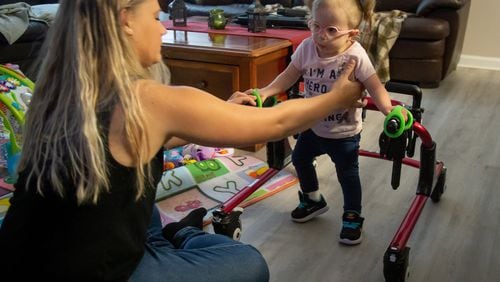When Stacey Clarke adopted her disabled 3-year-old from Vietnam, she promised the adoption agency he would have regular rehabilitation services to help him develop. She confidently supplied the name and address of the nearby outpatient therapy facility the family knew well in Fayette County, Children’s Healthcare of Atlanta. The boy came home to the Clarkes.
Then Children’s announced it was scaling back, stopping therapy at that location and several others Dec. 31.
“I’m sitting here, ‘Oh my gosh, we brought you home for these resources that we have here and now they’re leaving,’ ” said Clarke, who lives in Peachtree City. “As a parent, you’re like, what do I do?”
Children’s Healthcare of Atlanta does more than run hospitals. It’s a giant health care system offering services in scores of locations across the state, from urgent care in Cherokee County to pediatric cardiologists in Valdosta.
And it’s growing: It is developing a $1.3 billion hospital complex in Brookhaven that will eventually connect with a $1 billion medical complex Emory University is planning next door.
But Children’s says it took a hard look at the numbers and had to consolidate its locations for outpatient therapy — physical therapy and occupational therapy, which work on physical abilities such as walking, dressing and writing, as well as audiology.
It’s closing two locations entirely and reducing the types of services offered at four others. It will consolidate the remaining services at two northern Atlanta locations and one in Kennesaw. Those locations already see about half its outpatient rehab volume, Children’s said. About 1,300 patients will be affected by the moves.
“Ultimately, after taking a close look at our outpatient rehabilitation program, we had to make this decision,” Jessica Pope, a spokeswoman for Children’s, said in an email. “But we are committed to maintaining access to our outpatient rehab. We will be working closely with patient families to help those who wish to transfer their rehabilitation care to our consolidated facilities.”
Among patient families the news set off a storm of calls to try to get a new therapist. Some tried Children’s in Atlanta. Others couldn’t deal with the longer round trip, which now could turn from a morning off work to sapping a whole workday.
Clarke’s other kids had been patients, but her new son wasn’t yet. She contacted the Children’s locations that will remain open but found them too busy to take new patients or even put her on a waiting list.
Money in the bank
Unlike some Georgia hospitals, Children’s is not poor.
In a required document that Children’s filed to reassure lenders for its new Brookhaven project, the health system said it had more than $4 billion in cash and investments on hand, enough if necessary to fund itself for 1,100 days.
Georgia Medicaid covers almost all poor children, so Children’s has almost no uninsured patients. It also has a powerful fundraising arm. And because of its brand, Children’s has a lot of leverage negotiating reimbursement rates with insurance companies.
Financially, pediatric hospitals do better than most, according to the bond ratings agency Standard & Poor’s.
But Children’s Healthcare of Atlanta does best. In looking at whether nonprofit pediatric hospitals can pay their debts, the Standard & Poor’s ratings agency gave the Atlanta health system a better rating for financial health than all the other hospitals it evaluated.
Outsiders can only speculate on the details that made Children’s consolidate the rehab locations. Chris Kane, a hospital consultant, said small locations would raise financial complications for therapy. A big expense in therapy is the stretches of dedicated time a professional spends with a patient. Patients schedule in advance and at regular intervals. So if one patient calls in sick, in a small location that professional may be sitting around wasting time.
But there’s no shortage of need in Georgia, said Debi Hinerfeld, an occupational therapist who works with children in Roswell and also has a doctorate in health care administration. Children’s patients said their locations always seemed packed.
For them, losing Children’s also raises questions about the quality of care. The patients the AJC spoke to had high praise for their Children’s therapists.
In that regard, those who are able to stay with Children’s have a silver lining. In her email, Pope pointed out that patients at the consolidated locations will be nearer to experts. “By consolidating locations, we are enhancing our ability to provide high levels of service for acute patients. This includes increasing access to specialty services staffed by highly-skilled therapists,” she said.
“We see a difference”
Like any medical service, services such as occupational therapy, physical therapy and audiology help fix things that aren’t working right. The therapist evaluates the patient and creates a therapy regimen. They help the patient develop muscles and abilities that would not have developed otherwise, or at least not as quickly.
It’s carefully designed.
For example, just as a hip surgery allows a retiree with arthritis to walk, over time physical therapy pushes children into activity that develops muscles that allow them to walk. Occupational therapy assesses the child’s everyday environment and helps the child function in it, learning and developing muscles and brain paths to dress, hold things or eat.
Insurance coverage can be iffy. Schools may supply some therapy, but only if it’s school-related, Hinerfeld said. For example, they might allow a therapist to work on a child’s hand strength in order to hold down a piece of paper or lift a cafeteria tray, but not to be able to brush his or her hair.
Rehab therapy can start at the very beginning, said Sandra Schefkind, a pediatric practice manager at the American Occupational Therapy Association. For example, Schefkind said, recognizing before it’s too late that a disabled baby isn’t getting the time on his or her belly needed to develop neck and trunk muscles; and developing a way around that.
Hinerfeld said that with children, getting the correct therapy on time, and in the right amounts, is important.
Therapy for only half an hour once every two weeks did little for Georgia Minor of Peachtree City, as far as her mother, Kimberly Minor, could see. Georgia has a rare genetic condition called partial trisomy 18 monosomy 18. By 6 months old, when most babies are rolling around, scooting and trying to crawl, she couldn’t even hold up her head.
Though the state program Babies Can’t Wait provided the physical therapy, the Minors decided they’d try whatever it took to get Georgia developing better, including paying out of pocket. They went to Children’s.
There, therapists prescribed physical therapy for an hour every week. The therapist developed a bond with Georgia and not only worked with her, but taught Kimberly Minor how to continue sessions at home. The therapist told Minor she’d never seen a disorder like Georgia’s, so her theory was to try ambitious regimens and see whether they worked.
Within one month Georgia could stay sitting up, propped up by her own hands and arms.
She’s 3 now. “If she misses a week, we see a difference,” the mother said. “Now for her to go months on end without it petrifies me.”
The family can’t afford the weekly drive time to Atlanta from their home in Newnan, so they’re trying to get in with other therapy practices.
“I’m on a waitlist for somewhere in Villa Rica at this point,” she said. “I’ve been on it already for six months.”
CHANGES AT CHILDREN’S
Children’s Healthcare of Atlanta isn’t just a hospital. It’s a large health system that provides services including occupational and physical therapy and audiology and speech therapy. Children’s says declining volumes are forcing it to consolidate.
Keeping services:
Children’s Medical Office Building at Scottish Rite hospital in Atlanta at the northern Perimeter
Children’s at North Druid Hills in Atlanta north of the Downtown Connector
Town Center Outpatient Care Center in Kennesaw
Dropping some services, in most cases physical, occupational and speech therapy and audiology:
Childrens at Sandy Plains in Marietta (losing outpatient rehab, sports medicine physical therapy, and orthotics and prosthetics)
Children’s at Forsyth in Cumming
Children’s at Fayette, in Fayetteville
Children’s at Satellite Boulevard in Duluth
Locations and all services closing down:
Children’s at Alpharetta Highway in Roswell
Children’s at Mount Zion in Morrow
Source: Children’s Healthcare of Atlanta
About the Author








